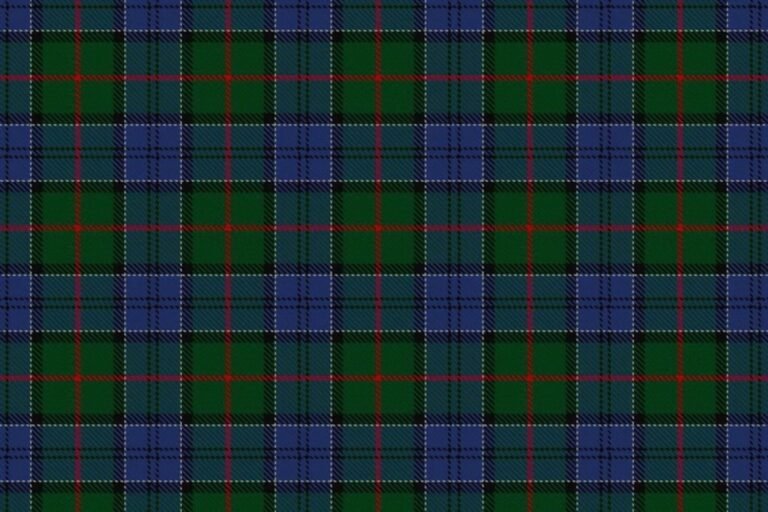Introduction
The clan colquhoun tartan is more than a pattern it’s a piece of history. It tells a story about a proud Scottish clan, its lands, and the people tied to it. In this article, we’ll explore what makes the clan colquhoun tartan special, its history, and its lasting place in modern culture.
What Is the Clan Colquhoun Tartan?
At its heart, the clan colquhoun tartan is a fabric pattern featuring green, blue, black, with thin red or white stripes. It comes in two versions ancient (lighter shades) and modern (darker shades). Both versions share the same design but differ in color tone, giving options for different tastes and uses.
A Glimpse into Clan Colquhoun’s Roots
The clan colquhoun tartan reflects the identity of a clan whose lands lie around Loch Lomond in Dunbartonshire. Clan Colquhoun traces back to the 13th century when Sir Humphrey de Kilpatrick received the lands and took the name Colquhoun. Their seat is at Rossdhu House, with the historic fortress of Dunglass Castle hovering nearby.
When Was the Tartan First Registered?
The clan colquhoun tartan was woven by Wilson’s of Bannockburn in the early 19th century. It was recorded in their pattern books circa 1819 and formally registered by Sir James Colquhoun with the Highland Society of London in 1817. Interestingly, Sir James had likely used this tartan when raising local volunteers around Loch Lomond in the late 1700s.
Ancient vs. Modern: What’s the Difference?
-
Ancient Version: Uses lighter, softer shades of green and blue.
-
Modern Version: Features deeper and darker tones of the same colors.
Both serve fashion and tradition alike, giving wearers meaningful choices.
Threads and Design: What Goes Into the Tartan
This tartan follows a classic sett with green and blue blocks highlighted by thin red and white lines. The thread counts were documented such as B/4 K4 B32 K32 W4 G32 R/8 showing the precision behind its design.
A Family Tartan That Speaks to Many
The clan colquhoun tartan isn’t just for Colquhouns. Many septs share this heritage, including Calhoun, Cowan, Ingram, Kilpatrick, Kirkpatrick, Laing, McCowan, McManus, McLintock, and others.
The Tartan Continues to Set Trends
Today, the clan colquhoun tartan finds new life in kilts, scarves, ties, blankets, and even dog bandanas. It’s more than tradition it’s art being woven into modern culture.
Historical Spark: The Battle of Glen Fruin
The Colquhoun clan once faced tragic loss in the Battle of Glen Fruin (1603) against Clan MacGregor. The tartan, tied to the clan identity, carries echoes of resilience that were forged in times of conflict.
Why the Tartan Still Matters
The clan colquhoun tartan reminds us of identity, land, and family. It teaches us about Scottish history, clan pride, and how patterns can connect us across generations. From celebrations at the Luss Highland Gathering to everyday fashion, it carries a quiet strength and beauty.
FAQs about the Clan Colquhoun Tartan
1. What does the clan colquhoun tartan look like?
It features green and blue checks with thin stripes of red and white.
2. Why are there ancient and modern versions?
Ancient versions are lighter in shade; modern versions are deeper and richer in color.
3. When was it officially registered?
Sir James Colquhoun registered it in 1817 with the Highland Society of London.
4. Who else can wear this tartan?
Sept families like Calhoun, Cowan, Ingram, and others are also linked to this tartan.
5. Where can I find items made with this tartan?
You’ll find kilts, accessories, homewares, textiles, and more at shops that feature Scottish tartans.
6. Does the tartan reflect clan history?
Absolutely. It’s tied to the clan’s lands, battles, and cultural legacy in Dunbartonshire.
Conclusion
The clan colquhoun tartan weaves together threads of history, identity, and craftsmanship. Its pattern carries stories of clan strength, hardship, and heritage. Whether worn at celebrations or displayed as home decor, it continues to connect people to their roots in a simple yet powerful way. If you cherish tradition or love a meaningful pattern, the clan colquhoun tartan offers a touch of heritage that feels alive today.
